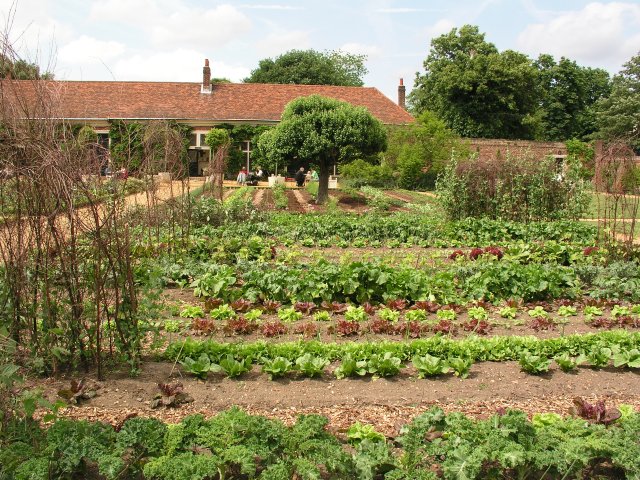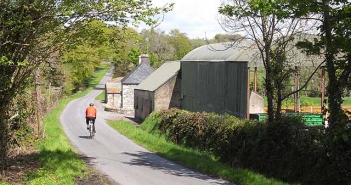Standing outside a Dublin hostelry in the drizzle, I fell into conversation with an Ulsterman who arrived with impeccable republican-socialist credentials. I assumed, this would make him sympathetic to the recently vanquished Labour leader Jeremy Corbyn.
I breezily opined that the long-serving MP for Islington had been the first post-War Labour leader to challenge a neo-colonial consensus in British politics, to which I received a surprising response.
“He’s just like the rest of them,” he said, pausing before almost spitting out the words, “the allotment,” and muttering “that’s how you can tell.”
Only on reflection do I recognise the origin of a prejudice against anyone holding an interest in the dark arts of composting, training vines, or even the life cycle of the carrot fly.
He echoed savage criticism of privileged do-gooders with an evangelical zeal for horticulture, from that most quintessential of English writers, George Orwell.

Hugh Fearnley Whittingstall
‘food-crank’
In The Road to Wigan Pier (1937) Orwell dismissed a certain type of socialist ‘food-crank’, ‘sandal-wearer’, ‘fruit-juice drinker’ as ‘a person willing to cut himself off from human society in hopes of adding five years on to the life of his carcass; that is, a person out of touch with common humanity.’
He maintained: ‘The ordinary human being would sooner starve than live on brown bread and raw carrots.’ But added, revealingly: ‘the peculiar evil is this, that the less money you have, the less inclined you feel to spend it on wholesome food.’
Orwell articulated an enduring English working class aversion to a New Age paternalism, which my Republican-Socialist interlocuter outside the pub appeared to share.
Well-intentioned, but often tone deaf, efforts to instil passion for horticulture continues to emanate from aristocratic scions such as Hugh Fearnley Whittingstall. His Dorset estate became a TV showcase for sustainable gastronomy in a country more renowned for mushy peas and fried batter, washed down with Irn-bru.
There is, however, a curmudgeonly quality to Orwell’s critique, reflected in a stated preference for Anglo-Saxon words over those of French or Classical origins in ‘The Politics of the English Language’. In England, and not only among working class, plain food, as well as plain words, are generally preferred over anything sophisticated, complex or, worst of all, French.
However, in my view, Corbyn comes from an honourable lineage of Ragged Trousered Philanthropists: genuine social reformers that secured parliamentary approval through the 1908 Small Holdings and Allotments Act. This brought 1,500,000 plots into cultivation by 1918, thereby ensuring a steady supply of fresh fruit and vegetables in many metropolitan districts.
It also led to a wide diffusion of gardening skills, which became a valuable resource during World War II when, denied of imports, the population was urged to Dig for Victory, with impressive results.
Nonetheless, what Orwell acknowledged as “the peculiar evil” of working class people turning their noses up at healthy produce suggests early industrialisation of food production in Britain – particularly the preponderance of refined sugar – had a lasting effect on the British pallet, and sadly the Irish one too.
In England today organic is a by-word for posh, and unaffordable: “not for the likes of you and me.”
Sadly, reflecting the colonial experience, Irish tastes are often just as blinkered. This is apparent in a lasting aversion to cultivating fruit and vegetables, which has informed the state’s agricultural priorities since independence.
Today just one percent of all Irish farms now produce vegetables – for reasons I explore.
The science behind Irish agriculture needs to involve a whole systems approach that takes into account all of the ecological consequences.https://t.co/FA6z9DMYtq@think_or_swim @whittledaway @sineadmercier @broadsheet_ie @ConorBlenner @LumberBob @itsmybike @ian_lumley @autofac
— CassandraVoices (@VoicesCassandra) June 7, 2020
Irish Food
Notably, the celebration of specifically ‘Irish’ food did not figure prominently among Irish nationalist at the end of the nineteenth century. Crucially, with the inception of the state, agriculture was identified as a primary source of export revenue.
This perpetuated a pattern of development that can be traced to the end of the Napoleonic wars in 1815, when a reduction in the price of grain on the British market created economic conditions in Ireland favouring raising cattle for export, often ‘on the hoof’.
The potato has long been identified with the Irish people, but it has not become a cherished foodstuff in the same way rice is to the Japanese for example. Early nationalists were more concerned with promoting self-sufficiency in wheat. Moreover, the Great Famine remains a relatively unexplored trauma, at least in terms of the Irish relationship with food, and the land.
Tony Kiely describes Dublin working- class meals in the 1950s as follows: ‘Family diets were very basic, consisting in the main of bread, tea, oatmeal, cocoa, potatoes, cabbage, herrings and pairings of cheap meat pieces for stews and soups .…’ While: ‘Bread was both a staple, and a constant companion at all meals.’[i]
Anthony Farmar suggests that an absolute rule among the Irish middle class in the 1960s was never to talk about food: ‘to enjoy eating as such was unbecoming to a serious person’. He quotes an American commentator who claimed cooking in Ireland was ‘a necessary chore rather than an artistic ceremony, and that in restaurants “‘nine out of ten ordered steak every time with nine out of ten ordering chips with it.”’[ii]
Among the post-Great Famine diaspora, there is little evidence of recreation of native dishes. Panikos Panayi claims that in Britain: ‘Irish food did not have enough distinction from that of the ethnic majority to warrant the opening of specifically designated food shops.’[iii]
Regarding nineteenth-century Irish-American immigrants, Hasia R. Diner reveals: ‘They rarely talked about food, neither did they sing about it, nor did it contribute to community institutions and rituals.’[iv]
Self-consciously Irish recipe books emerged only after independence. Most Irish nationalists did not view eating distinctively Irish food as an important cultural marker, except perhaps when it came to eating bread made from home-grown wheat.
Thus, in a pamphlet addressed to the women of Ireland, the writer and Irish language activist Mary Butler crafted a list of fifteen ways in which to foster authentic Irishness in their homes. Revealingly, ‘no traditional recipes, foodways, food names, or food practices as instruments for building Irish identity were included.’[v]
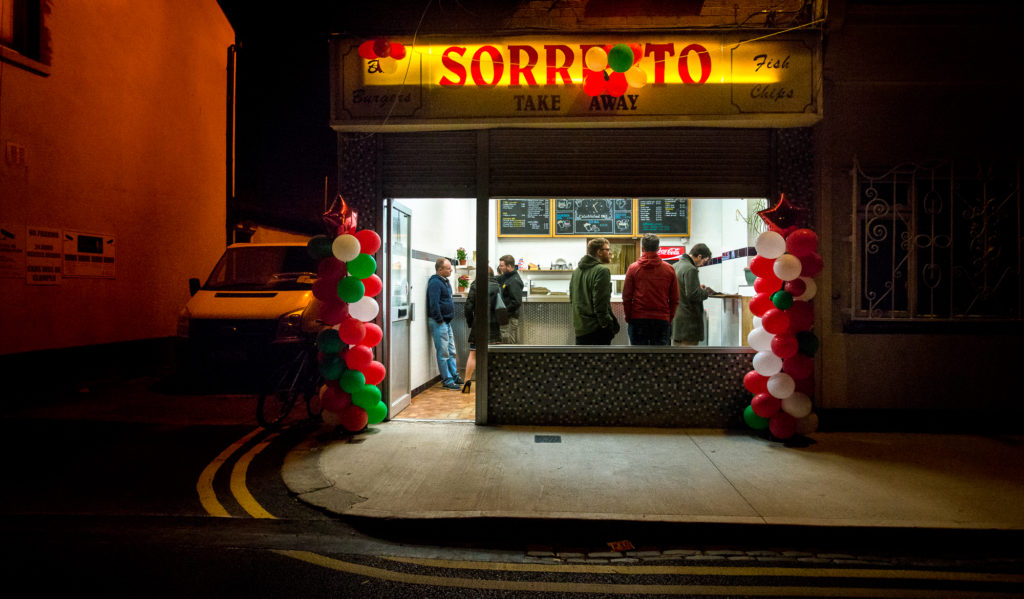
Image (c) Daniele Idini.
Aping the English
According to Benedict Anderson, ‘by the second decade of the nineteenth century if not earlier a model of the independent nation state was available for pirating.’[vi]
This is important in the Irish context as the model most readily available was English or British nationalism, a society that prized letters and sporting prowess, and in which a native culinary tradition had been ‘decapitated’[vii] by the end of the nineteenth century.
In 1880 the surgeon and polymath Sir Henry Thompson observed:
On questioning the average middle-class Englishman as to the nature of his food, the all but universal answer is, ‘My living is plain, always roast and boiled’—words which but too clearly indicate the dreary monotony, not to say unwholesomeness, of his daily food; while they furthermore express his satisfaction, such as it is, that he is no luxurious feeder.[viii]
The disinterest exhibited by the English in cookery and the discussion of food was compounded by the nutritional impoverishment of the working class.
Sidney Mintz estimates that by 1900 nearly one-fifth of average caloric intake came in the form of refined sugar, which was mainly consumed in tea or jam.[ix] Apart from being nutritionally deficient, this diet lacked variety and bred conservatism as older traditions of food preparation yielded to bland industrial products.
With no sophisticated models of food consumption to compete against, the Irish cultural elite was not drawn to food as an expression of identity; unlike Italians, for example, situated within the domineering cultural orbit of French cuisine.
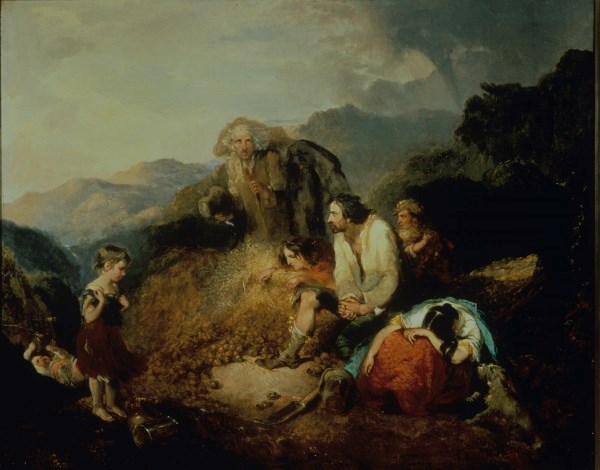
An Irish Peasant Family Discovering the Blight of their Store by Cork artist Daniel MacDonald, c. 1847
Poverty
This was compounded by the virtual extinction of many traditional foods as a result of poverty and changes in agricultural production in the wake of the Agricultural Revolution.
David Dickson ‘suspects that much of what is today regarded as traditional Irish cuisine—soda bread, barm brack, boxty, champ, colcannon etc—’ was only developed in the nineteenth century ‘in the kitchens of the solid farming class.’[x]
During the Famine, those unaffected by starvation bore witness to suffering on a scale that is hard for those of us living in contemporary Ireland to fathom. Joseph Lee likens its effects to the Jewish experience of the Holocaust and explores a psychological legacy:
They will have seen corpses, if not in their own dwellings, then on the roads and in the ditches. Many are likely to have felt a degree of guilt, of the type that often afflicts survivors of tragedies, not only of the Holocaust, but of events like earthquakes and mining catastrophes. Why did you survive when others in your family did not? A sense of guilt can simmer below the surface, to perhaps breakout in uncontrollable and, to uncomprehending outside observers, in apparently inexplicable ways.[xi]
Crawford and Clarkson concur, suggesting that survivors carried psychological scars and that their physical and intellectual developments were stunted.[xii]
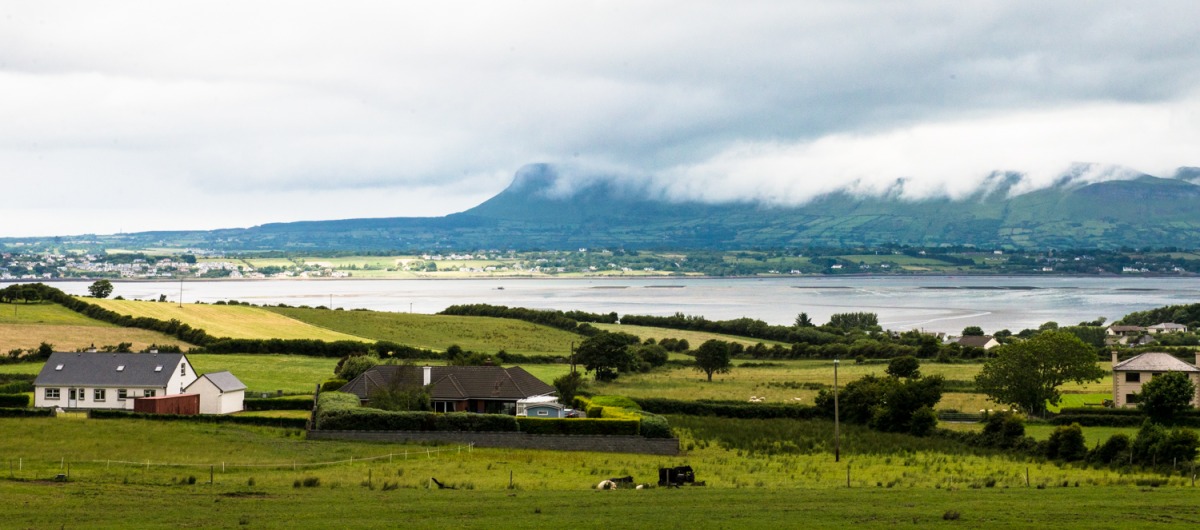
Image (c) Daniele Idini.
Alternative Crops
The dominance of the market generated a snobbery directed against foraged foods, which according to Louse M. Cullen acquired a ‘stigma.’[xiii]
Kevin Myers once mused in his Irishman’s Diary that: ‘It’s almost as if those who live on the land here are culturally and emotionally disengaged from its essence as a living thing.’[xiv]
The impact of colonisation cannot be overlooked. According to John Feehan: ‘it seems more than likely that the loss of the Gaelic tradition of farming was accompanied by a decline in the lore of wild plants and animals as food or medicine.’[xv]
Furthermore, the absence of a native ‘improving’ gentry, especially after the Act of Union in 1801, limited experimentation in and demand for ‘alternative’ crops: fruit and vegetables varieties with limited market value.
By the eve of the Great Famine three million (out of a population of eight million) were living on a mere one million acres of land, which represented just 5% of a the total acreage of 20 million.’[xvi] It is remarkable that until the blight arrived, without modern machinery or chemicals, so many were able to subsist on such small plots .

Moore Hall, County Mayo.
Lack of Variety
Writing in 1971, Rosemary Fennel bemoaned the demise of country markets, saying a ‘frequent complaint in Ireland is the lack of variety of in vegetables for sale and the high prices charged.’[xvii] Media coverage of the subject of food in the form of recipes, reviews and features only really took off in the 1990s.
It may be that the enduring absence of alternative agriculture and gastronomy owes something to the rejection of the ‘Big House’ in whose walled gardens, orchards and hothouses horticultural experimentation had occurred prior to independence, which precipitated the departure of a significant proportion of what remained of the landlord class.
In an independent state dominated by a petit -bourgeois farmer class, the Big House, was despised. In 1944 the Minister for Lands Sean Moylan condemned them as ‘tombstones of a departed aristocracy’ remarking ‘the sooner they go down the better. They are no use.’[xviii] More recently Nuala O’Faolain admitted: ‘We cannot, or at least I cannot, look at the Big House without some degree of rage.’[xix]
Certainly, since independence the focus of the state has been on securing export revenue from agricultural produce. In her history, Mary Daly argues that ‘it is evident that the Department [of Agriculture]has traditionally looked at agricultural matters from the perspective of the producer rather than the consumer.’ She cautions that the identity of interests between farmers and the Irish nation ‘does not necessarily apply on issues such as food policy, or the environment.’[xx]
Securing land has never been easy. Frank Mitchell and Michael Ryan observed in 1997: ‘In Ireland it is still next to impossible to rent land on a lease of sufficient length to make improvements and where land can be bought it is often in small parcels at too high a price.’[xxi]
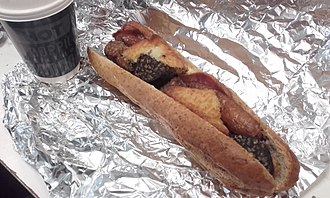
The Irish Breakfast Roll.
Changing Habits of a Lifetime
Pierre Bourdieu claims that ‘it is probably in tastes in food that one would find the strongest and most indelible mark of infant learning.’[xxii] Developing a taste for brown bread and carrots perhaps does not come easily if white bread and jam have been childhood staples.
One way to bring about a shift in Irish tastes could be through increased participation in small scale agriculture. This might lead to wider agricultural reforms, as people gain an appreciation of seasonality and even terroir – the unique flavour imparted by the growing environment.
A gastronomic awakening could lead to the cultivation of gardens across suburban and rural Ireland, and in more built-up areas public allotments – yes “allotments” – ought to be developed, but this will require state intervention.
More public land should be set aside for allotments given the importance of consuming sufficient fresh fruit and vegetables in our diets; not to mention the potentially huge savings if people were able to grow more of their own. Recall that on the eve of the Great Famine three million were subsisting on a mere one million acres of land!
My own district of Dun-Laoghaire Rathdown, which contains vast under-utilised parklands has just two public allotment sites available for a population of over two hundred thousand. One at Goatstown with 136 plots and another in Shankhill with 95 plots. Unsurprisingly, both are over-subscribed.
Meanwhile in the more congested Dublin City Council region, where there is still ample public land availabe, some zoned Z9 for Lands/Green Network, there are nine, again over-subscribed, sites.
Until there is an adequate distribution of land, horticulture will remain a privilege of property owners with gardens. This has important implications for the endurance of the perception that fresh fruit and vegetables are ‘posh’ food.
[i] Tony Kiely, “We managed”: reflections on the culinary practices of Dublin’s working class poor in the 1950s’, in Máirtín Mac Con Iomaire and Eamon Maher (eds) Tickling the palate, gastronomy in Irish literature and culture (Oxford, 2014), p.108.
[ii] Anthony Farmar, Privileged lives: a social history of middle class Ireland 1882-1989, (Dublin, 1989), p.180-2
[iii] Panikos Panayi, The multicultural history of British food (London, 2008), p.43.
[iv] Hasia R. Diner, Hungering for America: Italian, Irish and Jewish foodways in the age of migration. (Cambridge, 2002), p.114.
[v] Ibid, p.84.
[vi] Benedict Anderson, Imagined Communities: reflections on the origin and spread of nationalism, (London, 1991), p.81.
[vii] Stephen Mennell, All Manners of Taste: eating and taste in England and France from the Middle Ages to the present (Oxford, 1996) p.214.
[viii] Ibid, p.296.
[ix] Sidney Mintz, Sweetness and Power: the place of sugar in modern history, (New York and London, 1985) p.6
[x] David Dickson, ‘The potato and the Irish diet before the Great Famine’, in Cormac Ó Grada (ed.), Famine 150 commemorative lecture series (Dublin, 1997), p.19.
[xi] Joseph Lee, ‘The Famine in Irish history’, in Cormac Ó Grada (ed.), Famine 150 commemorative lecture series (Dublin, 1997), pp.168-9
[xii] Leslie Clarkson and Margaret Crawford, Feast and Famine, (Oxford, 2001), p.134.
[xiii] Louse M. Cullen, The Emergence of Modern Ireland 1600-1900 (London, 1981), p.173
[xiv] Irish Times, 30 January 2001.
[xv] John Feehan, Farming in Ireland, (Dublin, 2003), p.201.
[xvi] Raymond Crotty, Irish Agricultural Production: Its Volume and Structure, (Cork, 1966), p.63
[xvii] Rosemary Fennell, ‘The domestic market for Irish agricultural produce’, in Baillie and Sheehy, Irish agriculture in a changing world, p.106.
[xviii] Terence Dooley, ‘The Big House and Famine memory: Strokestown Park House’, in Crawley, Smith and Murphy, Atlas of the Great Irish Famine, p.625.
[xix] Ibid, p.628.
[xx] Mary Daly, The First Department: a history of the Department of Agriculture, (Dublin, 2002), p.428
[xxi] Frank Mitchell and Michael Ryan, Reading the Irish Landscape (Dublin, 1997), p.356
[xxii] Pierre Bourdieu, Distinction: a social critique of the judgment of taste, trans. by Richard Nice, (London, 2010), p.71.

